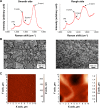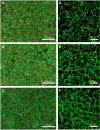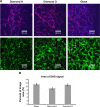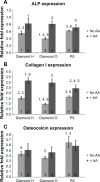Osteogenic cell differentiation on H-terminated and O-terminated nanocrystalline diamond films
- PMID: 25670900
- PMCID: PMC4315565
- DOI: 10.2147/IJN.S73628
Osteogenic cell differentiation on H-terminated and O-terminated nanocrystalline diamond films
Abstract
Nanocrystalline diamond (NCD) films are promising materials for bone implant coatings because of their biocompatibility, chemical resistance, and mechanical hardness. Moreover, NCD wettability can be tailored by grafting specific atoms. The NCD films used in this study were grown on silicon substrates by microwave plasma-enhanced chemical vapor deposition and grafted by hydrogen atoms (H-termination) or oxygen atoms (O-termination). Human osteoblast-like Saos-2 cells were used for biological studies on H-terminated and O-terminated NCD films. The adhesion, growth, and subsequent differentiation of the osteoblasts on NCD films were examined, and the extracellular matrix production and composition were quantified. The osteoblasts that had been cultivated on the O-terminated NCD films exhibited a higher growth rate than those grown on the H-terminated NCD films. The mature collagen fibers were detected in Saos-2 cells on both the H-terminated and O-terminated NCD films; however, the quantity of total collagen in the extracellular matrix was higher on the O-terminated NCD films, as were the amounts of calcium deposition and alkaline phosphatase activity. Nevertheless, the expression of genes for osteogenic markers - type I collagen, alkaline phosphatase, and osteocalcin - was either comparable on the H-terminated and O-terminated films or even lower on the O-terminated films. In conclusion, the higher wettability of the O-terminated NCD films is promising for adhesion and growth of osteoblasts. In addition, the O-terminated surface also seems to support the deposition of extracellular matrix proteins and extracellular matrix mineralization, and this is promising for better osteoconductivity of potential bone implant coatings.
Keywords: SHG; Saos-2; collagen; nanocrystalline diamond film; osteoblast.
Figures









Similar articles
-
Human osteoblast-like SAOS-2 cells on submicron-scale fibers coated with nanocrystalline diamond films.Mater Sci Eng C Mater Biol Appl. 2021 Feb;121:111792. doi: 10.1016/j.msec.2020.111792. Epub 2020 Dec 10. Mater Sci Eng C Mater Biol Appl. 2021. PMID: 33579442
-
Nanocrystalline diamond: In vitro biocompatibility assessment by MG63 and human bone marrow cells cultures.J Biomed Mater Res A. 2008 Oct;87(1):91-9. doi: 10.1002/jbm.a.31742. J Biomed Mater Res A. 2008. PMID: 18085649
-
Enhanced growth and osteogenic differentiation of human osteoblast-like cells on boron-doped nanocrystalline diamond thin films.PLoS One. 2011;6(6):e20943. doi: 10.1371/journal.pone.0020943. Epub 2011 Jun 10. PLoS One. 2011. PMID: 21695172 Free PMC article.
-
The Gemstone Cyborg: How Diamond Films Are Creating New Platforms for Cell Regeneration and Biointerfacing.Molecules. 2023 Feb 8;28(4):1626. doi: 10.3390/molecules28041626. Molecules. 2023. PMID: 36838614 Free PMC article. Review.
-
Adhesion, growth and differentiation of osteoblasts on surface-modified materials developed for bone implants.Physiol Res. 2011;60(3):403-17. doi: 10.33549/physiolres.932045. Epub 2011 Mar 14. Physiol Res. 2011. PMID: 21401307 Review.
Cited by
-
Coating Ti6Al4V implants with nanocrystalline diamond functionalized with BMP-7 promotes extracellular matrix mineralization in vitro and faster osseointegration in vivo.Sci Rep. 2022 Mar 28;12(1):5264. doi: 10.1038/s41598-022-09183-z. Sci Rep. 2022. PMID: 35347219 Free PMC article.
-
Polycrystalline Diamond Coating on Orthopedic Implants: Realization and Role of Surface Topology and Chemistry in Adsorption of Proteins and Cell Proliferation.ACS Appl Mater Interfaces. 2022 Oct 5;14(39):44933-44946. doi: 10.1021/acsami.2c10121. Epub 2022 Sep 22. ACS Appl Mater Interfaces. 2022. PMID: 36135965 Free PMC article.
-
Key Challenges in Diamond Coating of Titanium Implants: Current Status and Future Prospects.Biomedicines. 2022 Dec 6;10(12):3149. doi: 10.3390/biomedicines10123149. Biomedicines. 2022. PMID: 36551907 Free PMC article. Review.
-
Effects of mechanical properties of carbon-based nanocomposites on scaffolds for tissue engineering applications: a comprehensive review.Nanoscale Adv. 2023 Dec 22;6(2):337-366. doi: 10.1039/d3na00554b. eCollection 2024 Jan 16. Nanoscale Adv. 2023. PMID: 38235087 Free PMC article. Review.
-
Neuronal Protein 3.1 Deficiency Leads to Reduced Cutaneous Scar Collagen Deposition and Tensile Strength due to Impaired Transforming Growth Factor-β1 to -β3 Translation.Am J Pathol. 2017 Feb;187(2):292-303. doi: 10.1016/j.ajpath.2016.10.004. Epub 2016 Dec 8. Am J Pathol. 2017. PMID: 27939132 Free PMC article.
References
-
- Schrand AM, Huang H, Carlson C, et al. Are diamond nanoparticles cytotoxic? J Phys Chem B. 2007;111(1):2–7. - PubMed
-
- Bacakova L, Grausova L, Vandrovcova M, et al. Carbon nanoparticles as substrates for cell adhesion and growth. Nanoparticles: New Research. 2008:39–107.
-
- Chen H, Shen J, Longhua G, Chen Y, Kim DH. Cellular response of RAW 264.7 to spray-coated multi-walled carbon nanotube films with various surfactants. J Biomed Mater Res A. 2011;96(2):413–421. - PubMed
-
- Liu D, Yi C, Zhang D, Zhang J, Yang M. Inhibition of proliferation and differentiation of mesenchymal stem cells by carboxylated carbon nanotubes. ACS Nano. 2010;4(4):2185–2195. - PubMed
Publication types
MeSH terms
Substances
LinkOut - more resources
Full Text Sources

